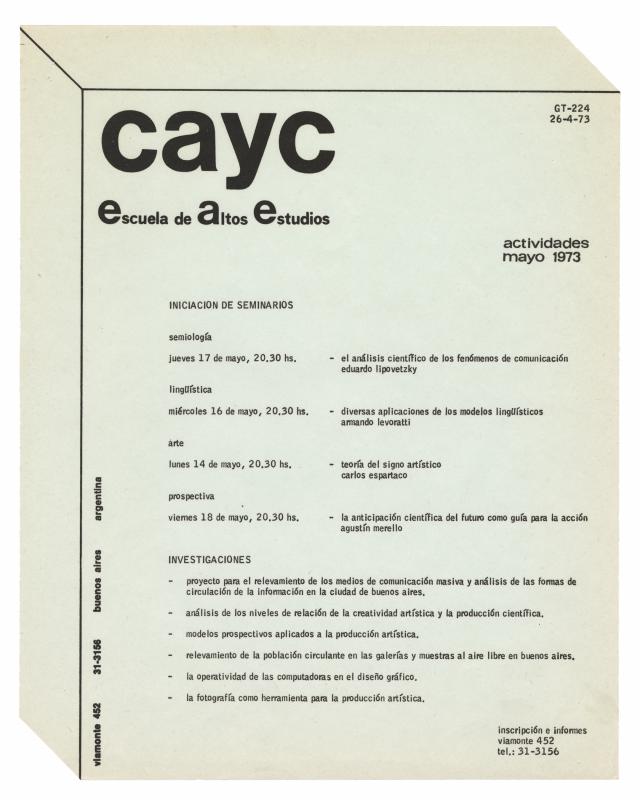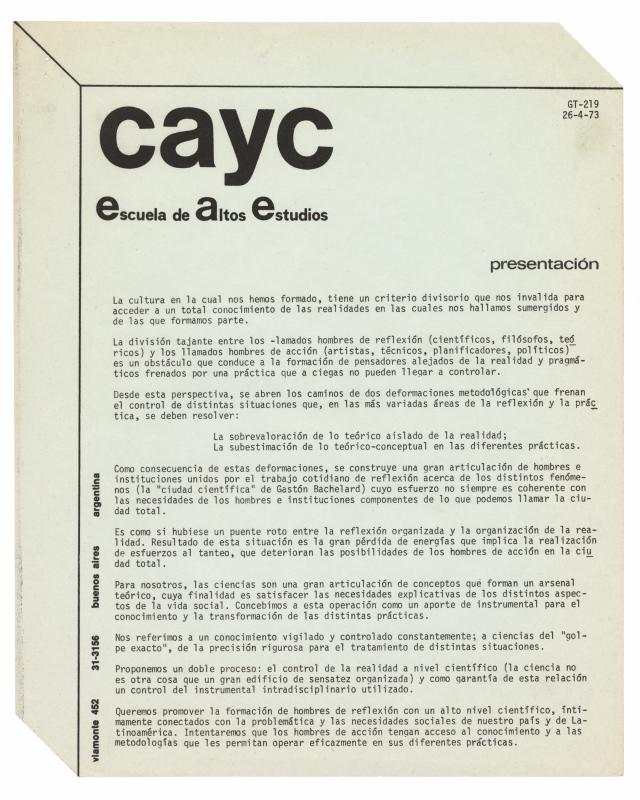Ever since it was founded, the CAYC (Centro de Arte y Comunicación), helmed by the cultural promoter, artist, and businessman Jorge Glusberg, was intended as an interdisciplinary space where an experimental art movement could flourish. The establishment of collaborative networks connecting local and international artists and critics played an important role in this process. In addition to the exhibitions, a program of different activities exposed attendees to the latest in art and scientific thinking. According to Glusberg, the coordination between theoretical thinking and artistic practice was an essential part of social change.
During the military dictatorship of General Juan Carlos Onganía, the CAYC became a cultural home for the Fundación de Investigación Interdisciplinaria, a space that welcomed a group of dissident professors from the Facultad de Arquitectura y Ciencias Exactas de la Universidad de Buenos Aires after the military takeover of the university in what came to be known as “La Noche de los Bastones Largos” in June 1966. In its early years the center organized a variety of activities with intellectuals that contributed to the circulation of ideas from different disciplines (analytical philosophy, mathematical logic, epistemological problems, psychology, semiotics, and linguistics), which had been excluded from official circles.
The center’s interest led to the creation of the Escuela de Altos Estudios (EAE) in early 1973. The objectives described in the relevant newsletters (GT-201; doc. no. 1478752, GT-201- A; doc. no. 1478753, GT-224; doc. no. 1478771, GT-219; doc. no. 1478755) were apparent in the activities organized by the EAE (some of which were more technical than interdisciplinary), as well as in the art produced by artists associated with the center. This initiative was an expression of the mood of openness of the “Cultural Spring” that flowered during the brief democratic presidency of Héctor J. Cámpora, which lasted forty-nine days in 1973. It was seen as putting an end to a seven-year period of military dictatorships (first under Onganía, then Levingston, and then Lanusse), after Peronism had been outlawed for eighteen years.
These circumstances impacted activities based on using prospect theory as a discipline for thinking about the future at a national and a regional level. Gustavo F. J. Cirigliano (1930–2012) was a philosopher who was focused on education and history and was sympathetic to Peronist ideas. He later expressed his thinking in his book La Argentina triangular: geopolítica y proyecto nacional (Triangular Argentina: Geopolitics and the National Project) (Buenos Aires: Humanitas, 1975). He advocated abandoning the agro-export model (associated with the so-called ’80s Generation) in favor of a different socioeconomic and cultural approach for Argentina that would improve its relations with neighboring countries. (Bolívar, J., Ríos, R. H., and De Lorenzo, J. L., Qué es el peronismo. Una respuesta desde la filosofía [What is Peronism? A Philosophical Reply], Buenos Aires, October, 2014.)


